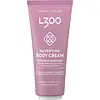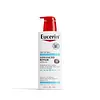What's inside
What's inside
 Key Ingredients
Key Ingredients

 Benefits
Benefits

 Concerns
Concerns

 Ingredients Side-by-side
Ingredients Side-by-side

Water
Skin ConditioningGlycerin
HumectantCaprylic/Capric Triglyceride
MaskingButyrospermum Parkii Butter
Skin ConditioningMyristyl Myristate
EmollientCoco-Caprylate/Caprate
EmollientPolyglyceryl-3 Methylglucose Distearate
EmulsifyingLactobacillus Ferment
Skin ConditioningCetearyl Alcohol
EmollientBetaine
HumectantHydrogenated Coco-Glycerides
EmollientSodium Chloride
MaskingUrea
BufferingLactic Acid
BufferingDimethicone
EmollientCetearyl Glucoside
EmulsifyingCaesalpinia Spinosa Gum
Skin ConditioningPentylene Glycol
Skin ConditioningSodium Hydroxide
BufferingTocopherol
AntioxidantCitric Acid
Buffering1,2-Hexanediol
Skin ConditioningDehydroacetic Acid
PreservativeCaprylyl Glycol
EmollientPhenoxyethanol
PreservativeBenzoic Acid
MaskingSodium Benzoate
MaskingWater, Glycerin, Caprylic/Capric Triglyceride, Butyrospermum Parkii Butter, Myristyl Myristate, Coco-Caprylate/Caprate, Polyglyceryl-3 Methylglucose Distearate, Lactobacillus Ferment, Cetearyl Alcohol, Betaine, Hydrogenated Coco-Glycerides, Sodium Chloride, Urea, Lactic Acid, Dimethicone, Cetearyl Glucoside, Caesalpinia Spinosa Gum, Pentylene Glycol, Sodium Hydroxide, Tocopherol, Citric Acid, 1,2-Hexanediol, Dehydroacetic Acid, Caprylyl Glycol, Phenoxyethanol, Benzoic Acid, Sodium Benzoate
Glycerin
HumectantUrea
BufferingCetearyl Alcohol
EmollientGlyceryl Glucoside
HumectantCyclomethicone
EmollientSodium Lactate
BufferingButyrospermum Parkii Butter
Skin ConditioningCaprylic/Capric Triglyceride
MaskingMethylpropanediol
SolventOctyldodecanol
EmollientDicaprylyl Ether
EmollientTapioca Starch
Glyceryl Stearate Se
EmulsifyingHydrogenated Coco-Glycerides
EmollientArginine Hcl
Skin ConditioningSodium PCA
HumectantDimethiconol
EmollientLactic Acid
BufferingCarnitine
CleansingCeramide NP
Skin ConditioningMannitol
HumectantSerine
MaskingSucrose
HumectantCitrulline
Skin ConditioningGlycogen
HumectantAlanine
MaskingThreonine
Glutamic Acid
HumectantSodium Chloride
MaskingSodium Cetearyl Sulfate
Cleansing1,2-Hexanediol
Skin ConditioningGlycerin, Urea, Cetearyl Alcohol, Glyceryl Glucoside, Cyclomethicone, Sodium Lactate, Butyrospermum Parkii Butter, Caprylic/Capric Triglyceride, Methylpropanediol, Octyldodecanol, Dicaprylyl Ether, Tapioca Starch, Glyceryl Stearate Se, Hydrogenated Coco-Glycerides, Arginine Hcl, Sodium PCA, Dimethiconol, Lactic Acid, Carnitine, Ceramide NP, Mannitol, Serine, Sucrose, Citrulline, Glycogen, Alanine, Threonine, Glutamic Acid, Sodium Chloride, Sodium Cetearyl Sulfate, 1,2-Hexanediol
Ingredients Explained
These ingredients are found in both products.
Ingredients higher up in an ingredient list are typically present in a larger amount.
1,2-Hexanediol is a synthetic liquid and another multi-functional powerhouse.
It is a:
- Humectant, drawing moisture into the skin
- Emollient, helping to soften skin
- Solvent, dispersing and stabilizing formulas
- Preservative booster, enhancing the antimicrobial activity of other preservatives
This ingredient is also known as shea butter. It is an effective skin hydrator and emollient.
Emollients help soothe and soften your skin. It does this by creating a protective film on your skin. This barrier helps trap moisture and keeps your skin hydrated. Emollients may be effective at treating dry or itchy skin.
Shea butter is rich in antioxidants. Antioxidants help fight free-radicals, or molecules that may harm the body. It is also full of fatty acids including stearic acid and linoleic acid. These acids help replenish the skin and keep skin moisturized.
While Shea Butter has an SPF rating of about 3-4, it is not a sunscreen replacement.
Shea butter may not be fungal acne safe. We recommend speaking with a professional if you have any concerns.
Learn more about Butyrospermum Parkii ButterThis ingredient is an emollient, solvent, and texture enhancer. It is considered a skin-softener by helping the skin prevent moisture loss.
It helps thicken a product's formula and makes it easier to spread by dissolving clumping compounds.
Caprylic Triglyceride is made by combining glycerin with coconut oil, forming a clear liquid.
While there is an assumption Caprylic Triglyceride can clog pores due to it being derived from coconut oil, there is no research supporting this.
Learn more about Caprylic/Capric TriglycerideCetearyl alcohol is a mixture of two fatty alcohols: cetyl alcohol and stearyl alcohol. It is mainly used as an emulsifier. Emulsifiers help prevent the separation of oils and products. Due to its composition, it can also be used to thicken a product or help create foam.
Cetearyl alcohol is an emollient. Emollients help soothe and hydrate the skin by trapping moisture.
Studies show Cetearyl alcohol is non-toxic and non-irritating. The FDA allows products labeled "alcohol-free" to have fatty alcohols.
This ingredient is usually derived from plant oils such as palm, vegetable, or coconut oils. There is debate on whether this ingredient will cause acne.
Due to the fatty acid base, this ingredient may not be Malassezia folliculitis safe.
Learn more about Cetearyl AlcoholGlycerin is already naturally found in your skin. It helps moisturize and protect your skin.
A study from 2016 found glycerin to be more effective as a humectant than AHAs and hyaluronic acid.
As a humectant, it helps the skin stay hydrated by pulling moisture to your skin. The low molecular weight of glycerin allows it to pull moisture into the deeper layers of your skin.
Hydrated skin improves your skin barrier; Your skin barrier helps protect against irritants and bacteria.
Glycerin has also been found to have antimicrobial and antiviral properties. Due to these properties, glycerin is often used in wound and burn treatments.
In cosmetics, glycerin is usually derived from plants such as soybean or palm. However, it can also be sourced from animals, such as tallow or animal fat.
This ingredient is organic, colorless, odorless, and non-toxic.
Glycerin is the name for this ingredient in American English. British English uses Glycerol/Glycerine.
Learn more about GlycerinHydrogenated Coco-Glycerides isn't fungal acne safe.
Lactic Acid is another well-loved alpha hydroxy acid (AHA). It is gentler than glycolic acid but still highly effective.
Its main role is to exfoliate the surface of the skin by loosening the “glue” that holds dead skin cells together. Shedding those old cells leads to smoother, softer, and more even-toned skin.
Because lactic acid molecules are larger than glycolic acid, they don’t penetrate as deeply. This means they’re less likely to sting or irritate, making it a great choice for beginners or those with sensitive skin.
Like glycolic acid, it can:
Lactic acid also acts as a humectant (like hyaluronic acid). It can draw water into the skin to improve hydration and also plays a role in the skin's natural moisturizing factor (NMF) in the form of sodium lactate.
Studies show it can boost ceramide production to strengthen the skin barrier and even help balance the skin’s microbiome.
To get results, choose products with a pH between 3-4.
Lower strengths (5-12%) focus on surface exfoliation; higher strengths (12% and up) can reach deeper in the dermis (deeper, supportive layer) to improve skin texture and firmness over time.
Though it was originally derived from milk, most modern lactic acid used in skincare is vegan. It is made through non-dairy fermentation to create a bio-identical and stable form suitable for all formulations.
When lactic acid shows up near the end of an ingredient list, it usually means the brand added just a tiny amount to adjust the product’s pH.
Legend has it that Cleopatra used to bathe in sour milk to help reduce wrinkles.
Lactic acid is truly a gentle multitasker: it exfoliates, hydrates, strengthens, and brightens. It's a great ingredient for giving your skin a smooth, glowing, and healthy look without the harshness of stronger acids.
Read more about some other popular AHA's here:
Learn more about Lactic AcidChances are, you eat sodium chloride every day. Sodium Chloride is also known as table salt.
This ingredient has many purposes in skincare: thickener, emulsifier, and exfoliator.
You'll most likely find this ingredient in cleansers where it is used to create a gel-like texture. As an emulsifier, it also prevents ingredients from separating.
There is much debate on whether this ingredient is comedogenic. The short answer - comedogenic ratings don't tell the whole story. Learn more about comegodenic ratings here.
The concensus about this ingredient causing acne seems to be divided. Research is needed to understand if this ingredient does cause acne.
Scrubs may use salt as the primary exfoliating ingredient.
Learn more about Sodium ChlorideUrea is also called carbamide and is the diamide of carbonic acid. In cosmetics, urea is used to hydrate the skin. It also provides exfoliation in higher concentrations.
As a humectant, urea helps draw moisture from the air and from deep within the skin. This helps hydrate your skin. Studies show urea is an effective moisturizer for dry skin conditions. 40% urea is typical in medications for treating eczema and other skin conditions.
Urea has the strongest exfoliation effect in concentrations higher than 10%. It is a keratolytic agent, meaning it breaks down the keratin protein in the top layer of skin. This helps remove dead skin cells and flaking skin.
In medicine, urea has been shown to help increase the potency of other ingredients, such as fungal treatments.
Humans and animals use urea to metabolize nitrogen-containing compounds. Urea is highly soluble in water. Once dissolved, it is neither acidic nor alkaline.
Learn more about Urea